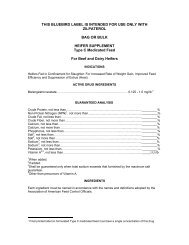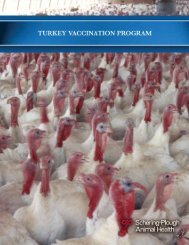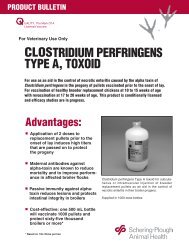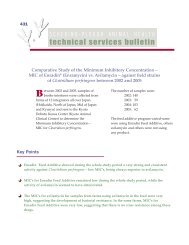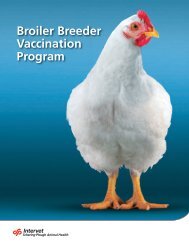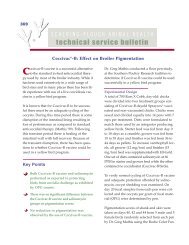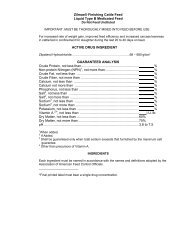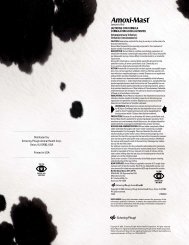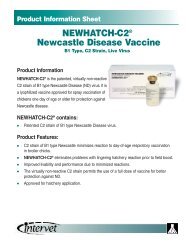P.G. 600® - Technical Report No. 1 - Merck Animal Health
P.G. 600® - Technical Report No. 1 - Merck Animal Health
P.G. 600® - Technical Report No. 1 - Merck Animal Health
Create successful ePaper yourself
Turn your PDF publications into a flip-book with our unique Google optimized e-Paper software.
Herd <strong>Health</strong>The control of reproductive failure is an integral part of the managementprocess. A good herd health program is essential to limiting reproductiveproblems. This involves an active interaction between the veterinarianand the swine producer. The increase in size and diversity ofmodern day swine operations has created a situation that necessitatesa closer and more regular involvement of the veterinarian, not only inthe prevention and control of disease, but also in many other aspectsof herd management. Routine herd visits at regular intervals are an excellentway to accomplish this. During these visits it is important for theveterinarian and the herdsman to communicate regarding managementpractices. Obviously, a thorough understanding of operational proceduresfacilitates the implementation of effective herd health management andthe isolation of factors responsible for reproductive failure.The practicing veterinarian needs to be a resource person for the swineproducer in herd health matters. In this context, knowledge of currentdevelopments concerning vaccination and prevention of disease, and newstrategies to implement this information in production situations, areessential. With regard to reproduction, veterinarians and producers needto stay informed about new compounds and their potential for controllingreproductive processes such as ovulation and farrowing. This involvesa thorough knowledge of what these compounds are designed to accomplish,the manner in which they produce their effect, any limitations ontheir use and other factors which influence their effectiveness. As a resourceperson it is important that the veterinarian consult and/or recruit theservices of specialists in other disciplines (nutrition, genetics, reproduction,engineering, etc.) when the need arises. In short, the role of the practicingveterinarian in effective reproductive management should be oneof active and regular involvement and should not be limited to the outbreakof reproductive disorders.Effective reproductive management from a herd health standpoint forboth the veterinarian and the swine producer involves monitoring reproductiveparameters in the operation. This is basically a form of qualitycontrol and a way to evaluate the effectiveness of a herd health program.Good record keeping systems are important for this to be effective.Table 1 contains a guide to reference standards for reproductive parametersand “decision boundaries” above or below which active controlmeasures may be necessary (Wrathall, 1982). This table is only a guidesince these values depend on the operation and the goals of the individualproducer. However, it may help the producer and veterinarian todecide what type of records are useful for evaluating the herd healthprogram.Once a problem has been detected, investigation, diagnosis, prognosisand control procedures usually follow. In this context, the working relationshipbetween the producer and the veterinarian is critical. Since clinicalsigns of ill health, such as changes in appetite, body temperature,etc., seldom are apparent in many reproductive disorders, monitoringthe reproductive performance of the herd is very important. <strong>No</strong>t onlydoes this allow detection of a problem, but it also provides a way toevaluate the effectiveness of the steps taken to eradicate or control theproblem.The various measures used to control reproductive disorders can be dividedinto three main categories:• Prevention—the elimination of the causative agent or the prevention of itsentry into the breeding herd.• Mitigation—the reduction of the amount of the causative agent to whichsusceptible animals are exposed.• Protection—the promotion of resistance to the causative agent in animals.Table 2, which was adapted from a review article by Wrathall (1982),summarizes the implementation of these measures in the control of reproductivefailure.Table 1. A guide to reference standards for reproductive parameters and “decision boundaries” above or below which active control measuresmay be necessary. (Wrathall, 1982)Reproduction Reference DecisionParameter Standard BoundaryAge at first service 225 days >240 daysWeaning to service interval 8 days >12 daysRegular returns to estrus (21 ± 3 days) 10% >20%Irregular returns 3% >6%Abortions 1% >2.5%Failures to farrow (detected at term) 1% >2%Farrowing rate 85% 80%Pigs born alive per litter (gilts) 9.5-10.0 3.0%Small litter index 1 12% >25%1Small litter index = percentage of litters with ≤ 8 pigs (dead or alive).6
Table 2. Guidelines for controlling reproductive failure in swine. (Adapted from Wrathall, 1982.)Causal factorsControl measuresPrevention Mitigation ProtectionGenetic factors1. Parental reproductive defects Difficult to prevent parental or Monitor reproductive performance Planned cross-breeding policy.progency defects completely. and remove offenders quickly.2. Progeny developmental defects Monitor for progeny defects (includingtest matings) and remove carriers.Nutrition1. Macronutrition (feed levels) Generous maintenance rations Individual feeding/prevent competition. Check body condition regularly.(wasteful?) Avoid climatic extremes, allow free Provide comfortable environment.Check feed levels and nutrient movement. Control parasites. Reduce stressors.content regularly.2. Micronutrients Keep above recommended levels Use straw bedding.(vitamins, minerals, etc.) for all known micronutrients. Vary sources of ingredients.Don’t overheat feed.Environment1. Climate (temperature, light, etc.) Difficult to prevent completely but Managerial vigilance. Adequate nutrition plus body2. Social influences design of buildings is fundamental. Flexible housing structure and layout. Condition checks.3. Structure (building design, Ventilation. Straw bedding. Use genetically adapted breeds/confinement, etc.) Facilitate necessary social interactions. strains of pig.Toxic substances1. Toxic food ingredients and Precautions re food ingredients and Avoid exposure to possible toxic Seldom possible to promote anycontaminants (e.g. mycotoxins) storage factors at highly vulnerable stages of resistance.breeding cycle.2. Chemicals (e.g. pesticides, Precautions re chemical hazards inPreservatives, gases)environment.3. Drugs (e.g. side effects of Precautions re use of drugshormones, vaccines)(especially hormones).Infections1. Commensals—opportunist Rarely possible to prevent Hygiene, disinfection, strategic use Boost immunity by exposure topathogens (mainly bacteria) completely. of anticiotics. infection at times of low risk (somevaccines, e.g. erysipelas).Use resistant breeds/strains of pig.Maintain body condition.2. Common contagious Keep self-contained herd and Difficult and may be inadvisable Promote immunity by exposure totransplacental pathogens (viruses) maintain strict disease security. except for very vulnerable stages virus at times of low vilnerability.New breeding stock by hysterectomy. (e.g. early pregnancy) where Use virus excretors, contaminatedAI, or by empryo transplant. isolation, hygiene and disinfection environment, or infected foetuses andmay help.placenta. Vaccines?3. Specific reproductive pathogens Eradicate (national policy) or Seldom practical in long term. In Vaccination or exposure to infection(e.g. Brucella suis, Leptospira and eliminate from herd by testing and short term hygiene, atnibiotic at times of low vulnerability.many others) culling. treatments, culling of clinical cases Use resistant breeds/strains of pig.Strict disease security, testing of new and special measures for individualentrants and quarantine.diseases may help.Opportunities for Controlled ReproductionIn the previous sections, various components of the production environmentand their role in reproductive management were discussed. Theseprovide the producer with some control over the occurrence of reproductiveevents. Sometimes it is necessary and/or desirable to controlreproductive processes in gilts and sows more precisely and efficientlythan is possible with these methods. One way is by treatment with theexogenous hormones that stimulate the normal progression of reproductivechanges.OvulationA good example of this is the control of ovulation. Ovulation is the culminationof follicular growth. As mentioned in the first section of thispublication, follicular growth and ovulation are controlled by two hormones:FSH and LH. Consequently, by treating sows and gilts with FSHand LH or with compounds which have similar biological activities, folliculardevelopment and ovulation can be induced and synchronized veryeffectively. For example, in both prepuberal gilts (180 days of age) andpostweaning sows, ovulation has been induced in a large percentage of7
P.G. 600 ®ProducP.G. 600®t Name Here ®animals (70 to 90%) with FSH and LH like compounds. Additionally, thetimed ovulation in both groups was highly synchronized. A treatmentwhich is capable of inducing and synchronizing heat periods and ovulationhas tremendous potential as a tool in effective reproductive management,allowing more efficient use of facilities, labor, boar power andother inputs.Pregnant Mare Serum Gonadotropin (PMSG) also known as serumgonadotropin) and human chorionic gonadotropin (HCG) are two hormoneswhich mimic the effects of FSH and LH on follicular growth andovulation. Numerous studies have demonstrated that treatment with PMSGfollowed 72 to 96 hours later by HCG is an effective way of inducingand synchronizing heat periods in prepuberal gilts. A compound calledP.G. 600®, which contains both PMSG and HCG, has been approved forinducing estrus. In several studies in market-weight crossbred gilts, P.G.600® improved several measures of reproduction. Within 28 days of treatment,72.9% of the gilts treated with P.G. 600® exhibited estrus, comparedwith 59.5% of the untreated females. Of the treated gilts, 21.9%more were in estrus between 1 and 7 days after treatment. The percentageof gilts farrowing and the number of pigs per litter were notdifferent between the control and treated groups.Induced FarrowingAnother reproductive event which can be controlled very precisely isparturition. The decrease in progesterone at the end of gestation stimulatesthe birth process. In swine, prostaglandin (PGF) causes luteolysis,which results in the decline of progesterone. This knowledge has beenused to induce and synchronize parturition in swine. Specific trials havedemonstrated that sows and gilts receiving intramuscular injections ofcertain prostaglandins on days 111, 112 or 113 of gestation farrow within48 hours after treatment. In these studies, 92% of the treated femalesfarrowed as compared to 38% of the control dams. Some of the benefitsof induced parturition are:• Closer supervision at farrowing, which can result in the increasedopportnity to save more piglets.• Efficient use of facilities.• Batching of routine tasks.Obviously, the combination of the two treatments discussed in this sectionprovides a means of controlling reproduction with a great deal ofprecision. For example, induction of ovulation in a group of prepuberalgilts could result in a large number of females at the same stage of gestation.Those animals could then be induced to farrow. Consequently,lactation and weaning would also be synchronized. In this situation, theestrus, parturition, weaning and postweaning estrus could conceivablyall occur on a given day as opposed to over several weeks. The efficacyand practicality of these combined treatments are being evaluated incontrolled experiments to determine their full potential.Selected ReferencesAberne, F.X. and R.N. Kirkwood. 1985. Nutrition and sow prolificacy J.Reprod. Fertil. Suppl. 33:169-183.Britt, J.H., J.D. Armstrong, N.M. Cox and K.L. Esbenshade 1985. Controlof follicular development during and after tactorion in sows. J. Reprod.Fertil. Suppl. 33:37-54Guthrie, H.D. 1985. Control of parturition time. J. Reprod. Fertil. Suppl.33:229-244.Hafez, E.S.E. 1980. Reproduction in Farm <strong>Animal</strong>s. Lea and Febigor,Philadelphia.Hemsworth, R.H. 1982. Social environment and reproduction. In: Controlof Pig Reproduction. D.J.A. Cole and G.R. Foxcroft (eds.) Butterworths.London, pp. 585-602.Hill, W.G. and A.J. Webb. 1982. Genetics and reproduction. In: Controlof Pig Reproduction. D.J.A. Cole and G.R. Foxcroft (eds.) Butterworths,London, pp. 541-564.Hughes, P.E. 1982. Factors affecting the natural attainment of pubertyin the gilt. In: Control of Pig Reproduction. D.J.A. Cole and G.R. Foxcroft(eds.) Butterworths, London, pp. 117-138.Hunter. R.H.F. 1982. Reproduction of Farm <strong>Animal</strong>s. Longman. London.Paterson, A.M. 1982. The controlled induction of puberty. In: Control ofPig Reproduction. D.J.A. Cole and G.R. Foxcroft (eds.) Butterworths. London,pp. 139-160.Pork Industry Handbook. 1987. Cooperative Extension Service.Sorenson, A.M., Jr. 1979. <strong>Animal</strong> Reproduction. Principles and Practices.McGraw-Hill. Inc., New York.Tomes, G.J. and H.E. Nielson. 1982. Factors affecting the reproductiveefficiency of the breeding herd. In: Control of Pig Reproduction. D.J.A.Cole and G.R. Foxcroft (eds.) Butterworths, London, pp. 527-540.Webel, S.K. 1978. Ovulation control in the pig. In: Control of Ovulation.D.B. Chrighton. N.B. Hayes, G.R. Foxcroft and G.E. Lamming (eds.)Butterworths, London, pp. 421-434.Wettemann, R.R. and E.W. Bazer 1985. Influence of environmental temperatureon prolificacy in pigs. J. Reprod. Fertil. Suppl. 33:199-208.Wrathall, A.E. 1982. Investigation and control of reproductive disordersin the breeding herd. In: Control of Pig Reproduction, D.J.A. Cole andG.R. Foxcroft (eds.) Butterworths, London, pp. 565-584.Intervet Inc.<strong>Technical</strong> <strong>Report</strong> <strong>No</strong>. 1Reproductive Performance of First Parity SowsAuthors: William L. Flowers, Ph.D.Billy N. Day, Ph.D.Intervet Inc. ■ P.O. Box 318 ■ 405 State Street ■ Millsboro, Delaware 199661.800.835.0541 (Information)8Part <strong>No</strong>.: 8002002 macgra04/02



